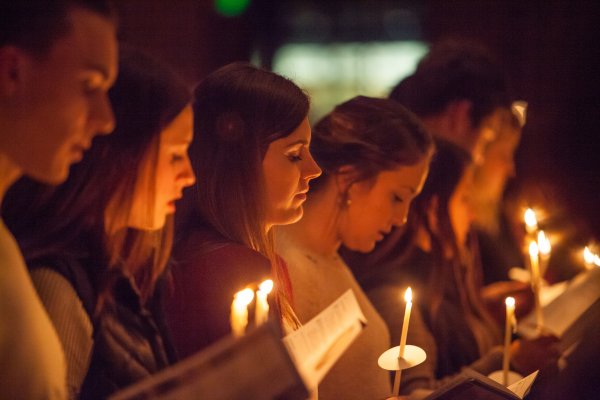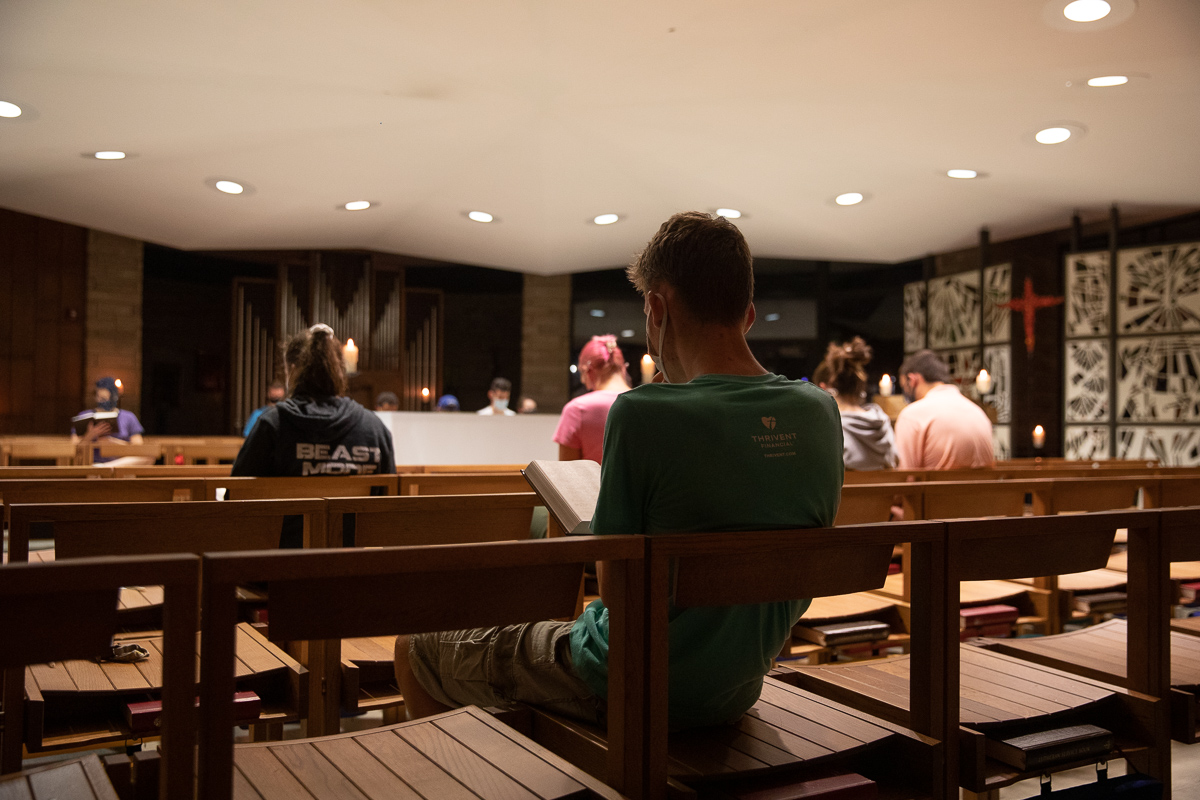Our History
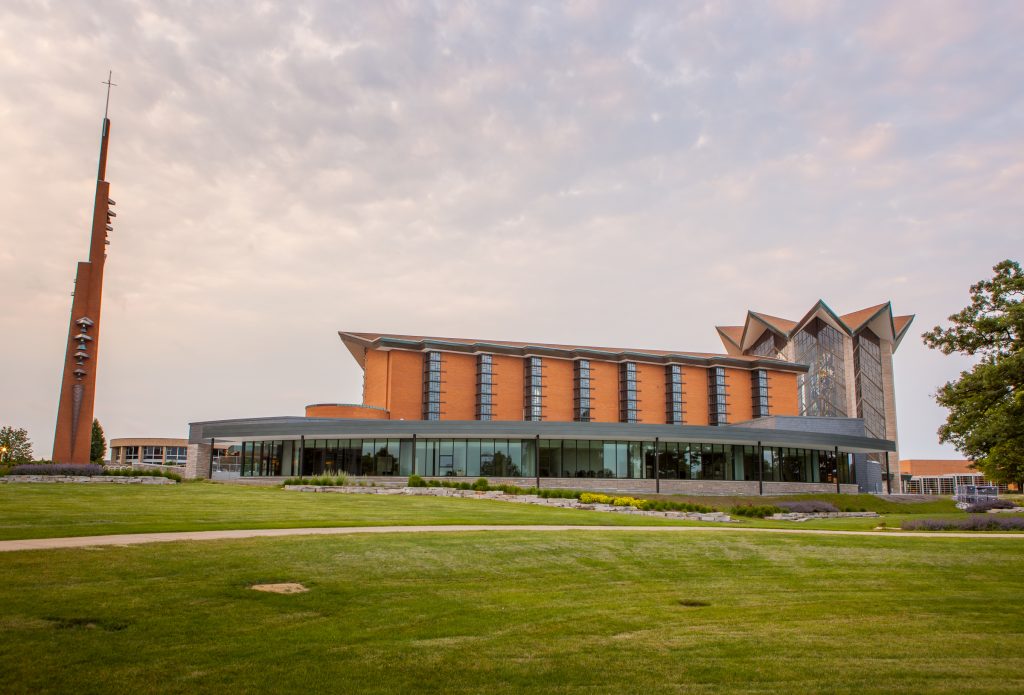
Towering above the surrounding landscape, the Chapel of the Resurrection is a manifestation of the character embodied by the Valparaiso University community.
The chapel was dedicated in 1959, three years after groundbreaking ceremonies. (You can view a copy of the dedication booklet from September 27, 1959.) Originally called Memorial Chapel in recognition of the many memorial gifts made to help fund its construction, it was named the Chapel of the Resurrection in 1969.
The chapel was built as a thanksgiving to God in the form of a place for corporate worship, and as a gathering place for the university community to participate in convocations, concerts, recitals, lectures and assemblies of a similar nature.
The basic structure was given as a thank offering by members of the Lutheran Church – Missouri Synod through a “Building for Christ” offering. Friends, benefactors, and alumni contributed gifts for the furnishing of the chapel.
The Reddell Memorial Organ and the Meier Music Window as well as the August H. & Ella Louise Brandt Campanile and Guild Carillon were also dedicated September 27, 1959.
Architect Charles Stade
Architect for the chapel was Charles Edward Stade and Associates of Park Ridge, Illinois. Professor Jean Labatut of Princeton University was planning consultant; the Rev. Dr. A.R. Kretzmann of the Evangelical Lutheran Church of Saint Luke, Chicago, liturgical consultant; and Professor Kenneth F. Mortimer of Valparaiso University, building consultant. Stade was the architect of several other buildings on the Valparaiso campus, including O.P. Kretzmann Hall, Meier Hall, Gellerson Center, Neils Science Center, Dickmeyer Hall, the President’s home (Linwood House) and the now-demolished Moellering Library.
Other designers were involved in special elements such as the stained glass windows and the baptistery. Construction costs totaled $7.5 million.
It has been said that inspiration for the design of the building was provided in part by the Church of the Nativity in Bethlehem. This plan has the chancel as the most significant part of the structure with the nave attached to it rather than the two areas being viewed only as a single building. The nave is 58 feet high and 193 feet long. There is seating for approximately 2,000 people, although capacity varies depending upon the configuration of the seats.
A work in progress
The chapel was first used for the Opening Convocation of the University September 14, 1958, one year before the chapel was dedicated. President O.P. Kretzmann presided at the convocation, and Professor Herbert Umbach, Professor of English – the faculty member with the longest tenure at the University – gave the opening prayer. At that time, photographs show that the stained glass windows in the chancel, the altar, the pulpit, the lectern, the communion rails, and the rails on either side of the chancel steps had not yet been installed.
Gloria Christi Chapel
The dedication of Gloria Christi Chapel (the chapel located in the east undercroft area — the lower level of the east end of the building) took place Sunday morning, September 27, 1959, the morning of the day the main chapel was dedicated. This chapel has also been known as the “Guild Chapel,” since the Valparaiso University Guild gave a substantial contribution toward its building. It is dedicated to the place where the glory of God was made manifest in Christ’s birth. This smaller chapel is the size of the chancel directly above it.
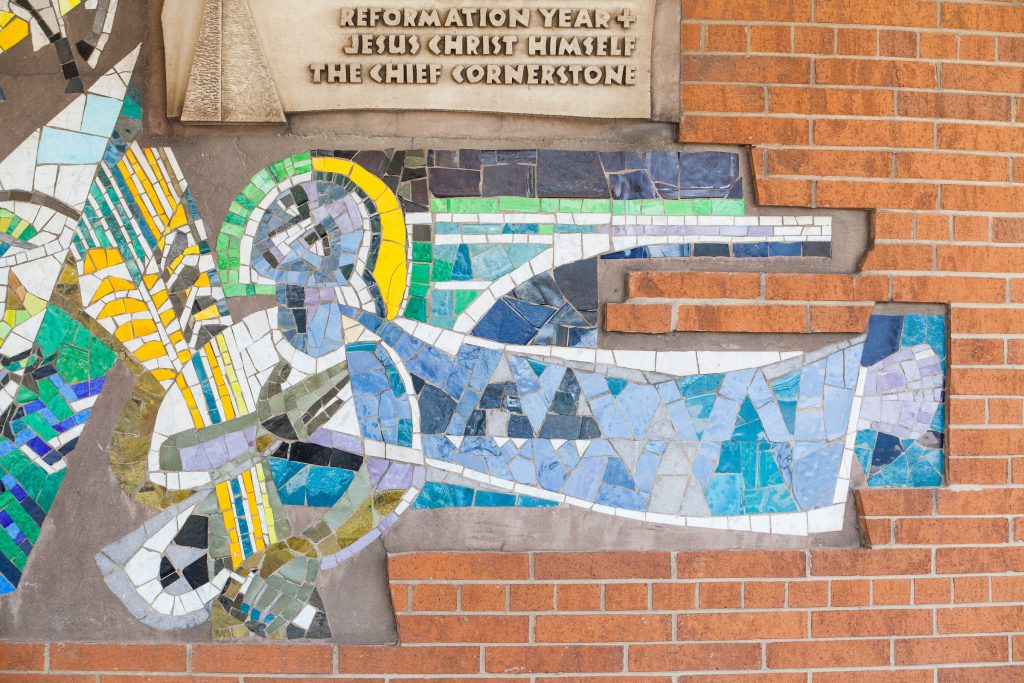
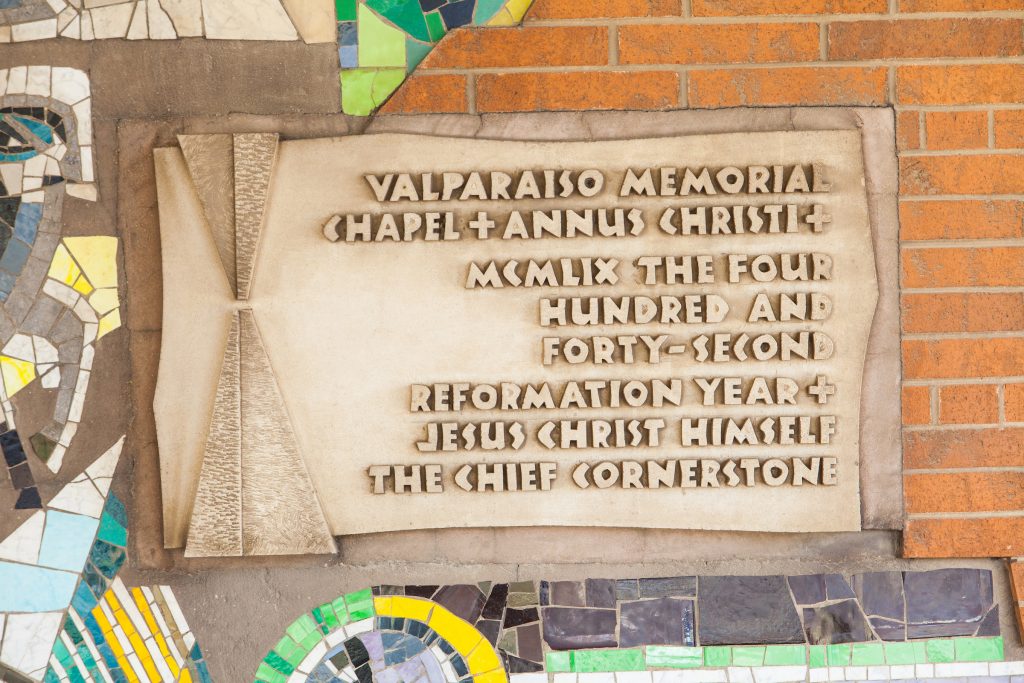
October 2, 1960: Cornerstone
The dedication of the cornerstone of the chapel took place October 2, 1960. Rev. Dr. O. P. Kretzmann, President of the University, was the officiant. The cornerstone mosaic is based on the Letter to the Ephesians, chapter two, verse twenty: “Jesus Christ himself as the cornerstone.” Here the Church is depicted in various symbols. In the lower part of the mosaic is an angel pictured as a reaper, gathering the faithful into the heavenly garners. Farther up, the people of God are represented as fish in the net, then as sheep in God’s pasture, and finally as the good fruit of Christ, the Vine, whose branches we are. At the top is a messenger angel bringing the good news.
February 5, 1961: Center Chancel Window
Sunday, Feb. 5, 1961 at 10:30 a.m., the center window — more than two years in the making — was dedicated. It depicts “the dawning of the New Day in Christ our Lord.” The window to its left will symbolize the work of God the Father, while the window to its right will be based on the work of God the Holy Spirit. The installation of this center window was made possible by a gift from Mr. and Mrs. Alfred C. Munderloh, of Detroit. Rev. Dr. O. P. Kretzmann, President of the University and Dean of the Chapel, was the preacher for the service.
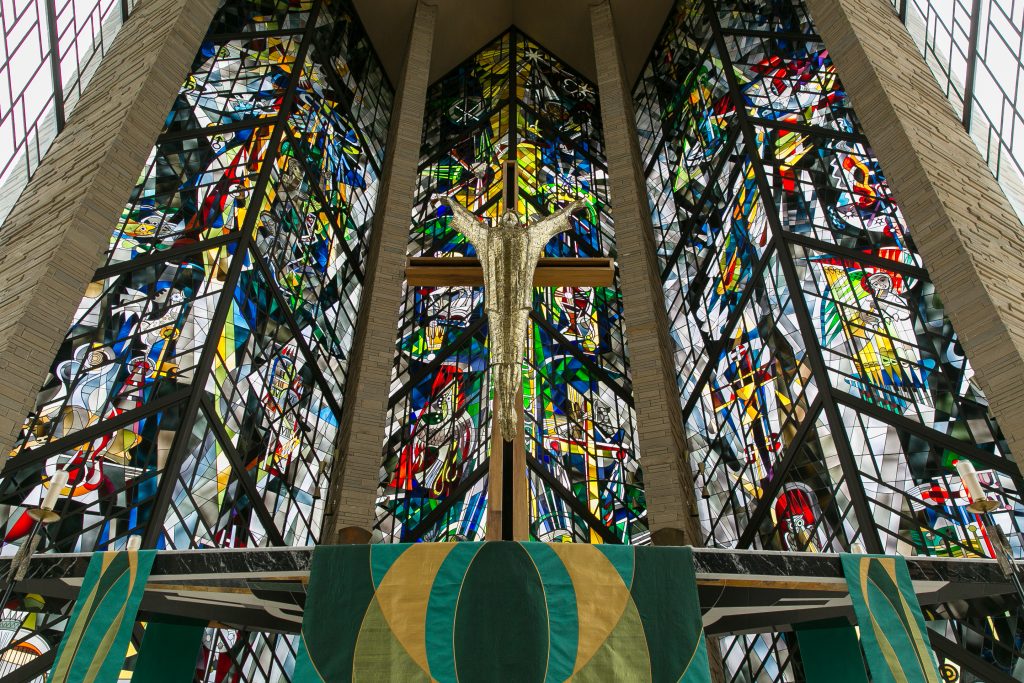
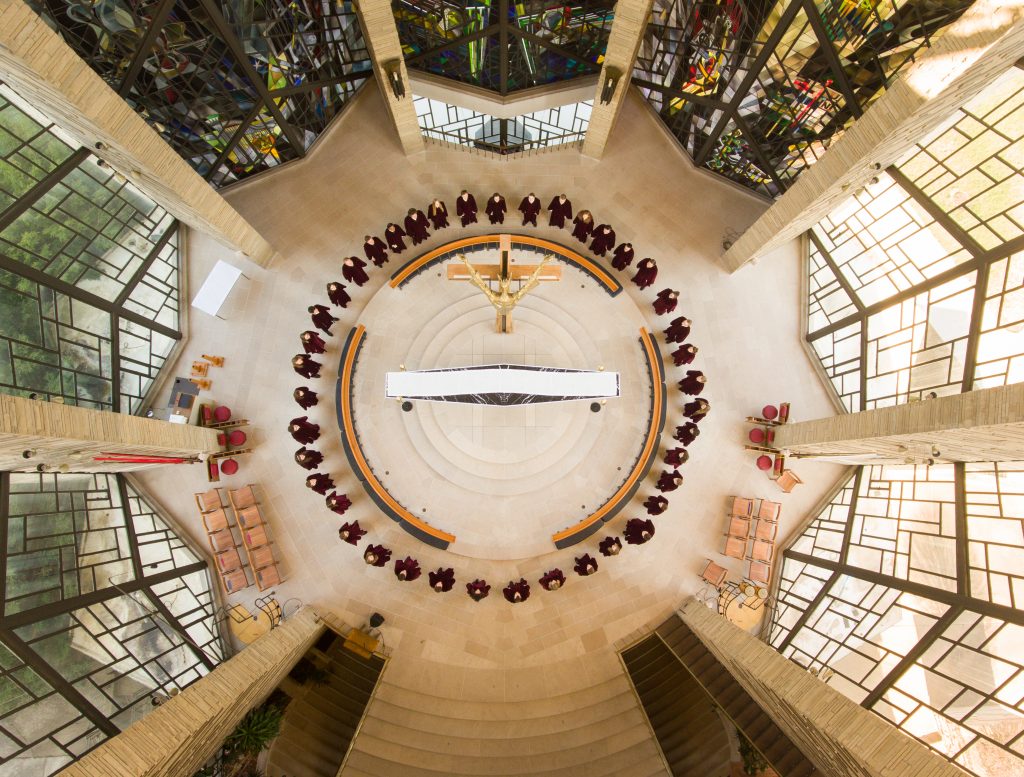
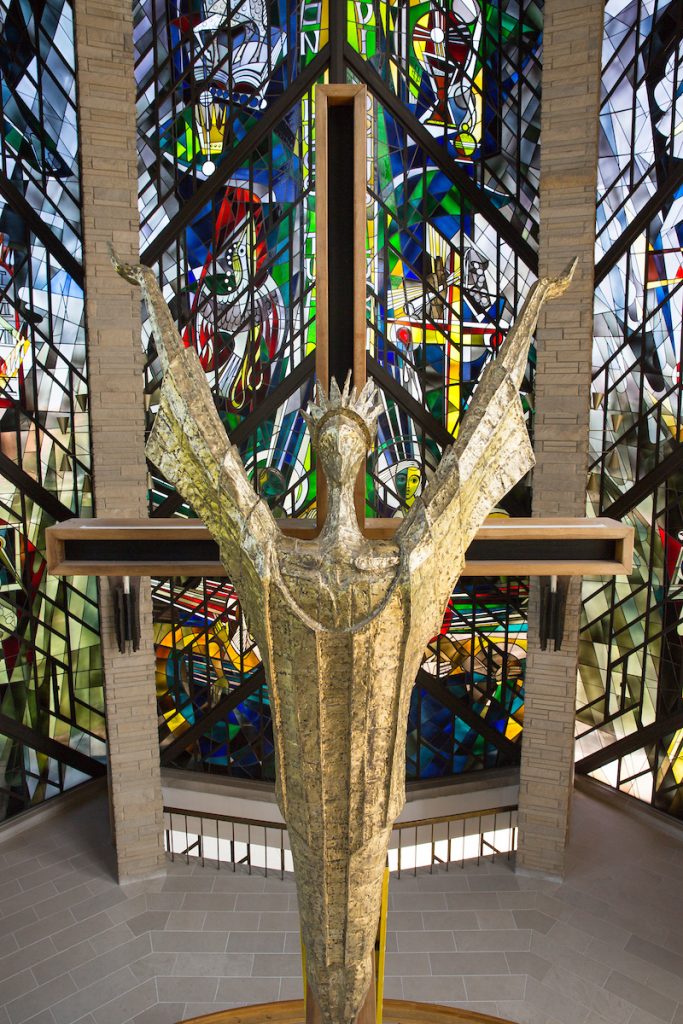
January 10, 1965: Altar, Munderloh Windows & Christus Rex
Dedication of the altar and Munderloh Windows took place at the Chapel on January 10, 1965.
The chancel of the Chapel of the Resurrection is 98 feet high and is circular in shape with a roof shaped like a nine-point star. It features the altar, Christus Rex and the Munderloh Windows. The twenty-one-foot-long free-standing altar is of black Italian marble, setting off symbols of the four Evangelists (Matthew, Mark, Luke and John). The altar was designed by the Peter Dohmen Studios of St. Paul, Minn.
The Christus Rex figure is affixed to the large cross which stands several feet behind the altar. The cross is twenty-one feet high, exactly the same height as the altar is in length. The Christus Rex is a “combination symbol” of both the crucifixion and the resurrection. The crowned figure, with head thrown back and arms uplifted, radiates the glory of a triumphant King who has conquered all forces – past, present, and future – which enslaved his people. His heavenward face and priestly vestments also reassert the intermediary role he fulfills between God and mortals. This figure was designed by David Elder, formerly of the Department of Art of Valparaiso University.
Forming the background for the altar are three stained glass windows (the Munderloh Windows) representing (from the left to right) the creative work of God the Father, the redemptive work of God the Son, and the Holy Spirit’s sanctifying gifts. The significance of these windows is to keep before the eyes of the worshipers, in public and in private devotions, the work of the Holy Trinity for the salvation of all people.These windows were designed by the Peter Dohmen Studios of St. Paul, Minn., in consultation with the Rev. A.R. Kretzmann, liturgical consultant for the Chapel’s construction.
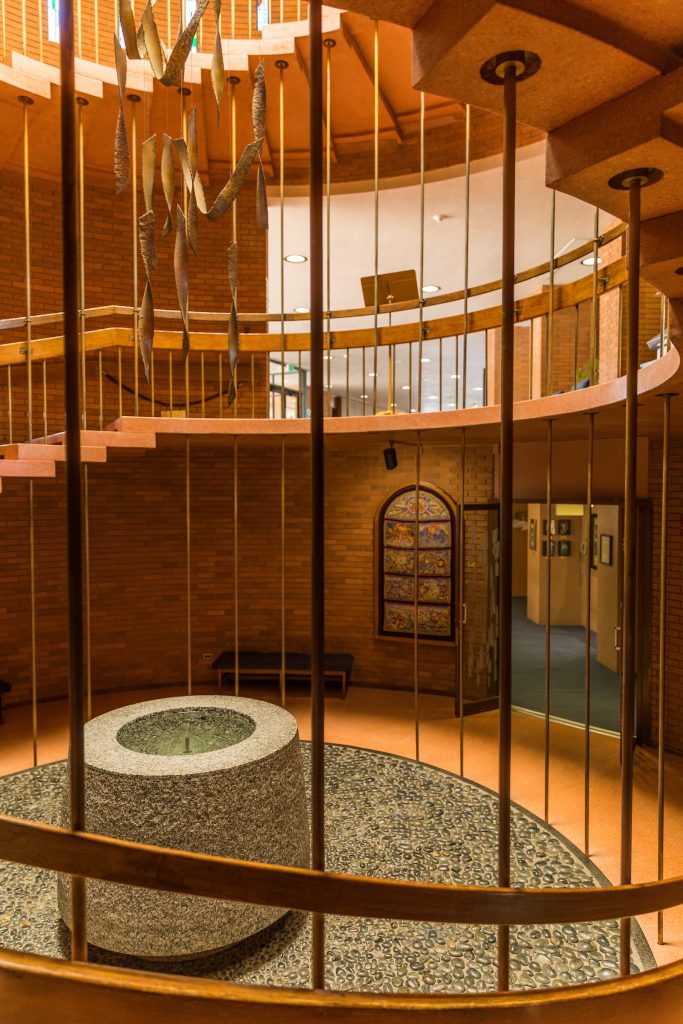
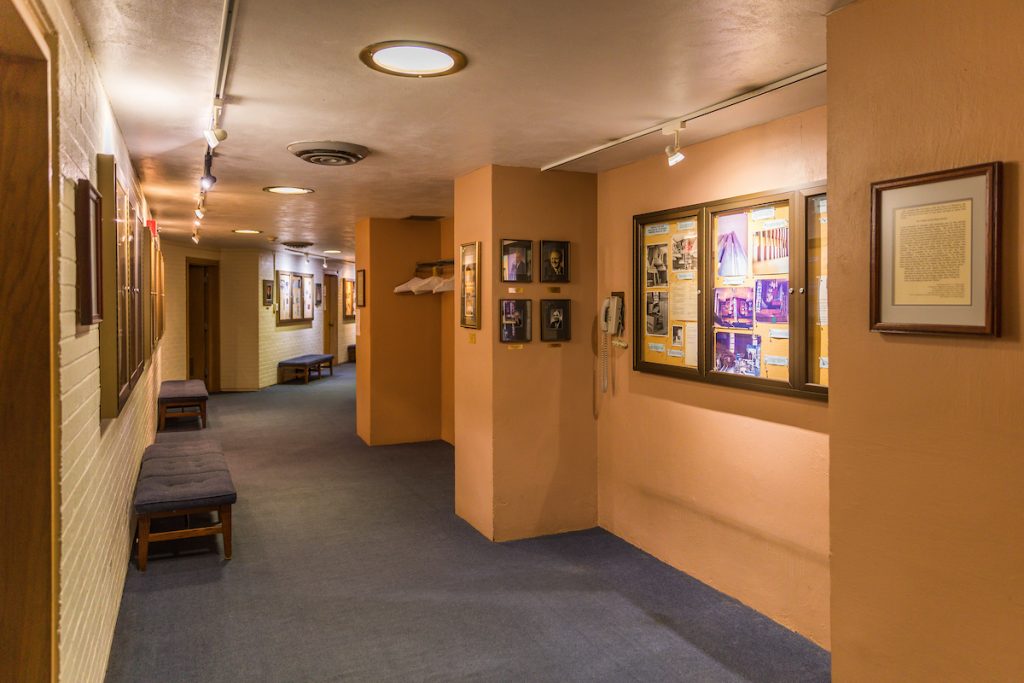
April 24, 1966: LeBien Baptistery
The completed baptistery was dedicated April 24, 1966. The baptistery was designed and built by Conrad Schmidtt Studios of New Berlin, Wis.
Located at the south end of the narthex, in the southwest corner of the chapel and down a flight of stairs, the LeBien Baptistery helps us understand baptism as our entrance into the church, the body of Christ. The entire area was designed as a series of concentric circles. The five and a half ton baptismal font is one block of Rockville granite with a natural cleavage surface. It contains continuously running water, a reminder of the continuing nature of the sacrament in the life of the child of God. During construction, the font was lifted by crane above the roof of the baptistery and lowered through the skylight.
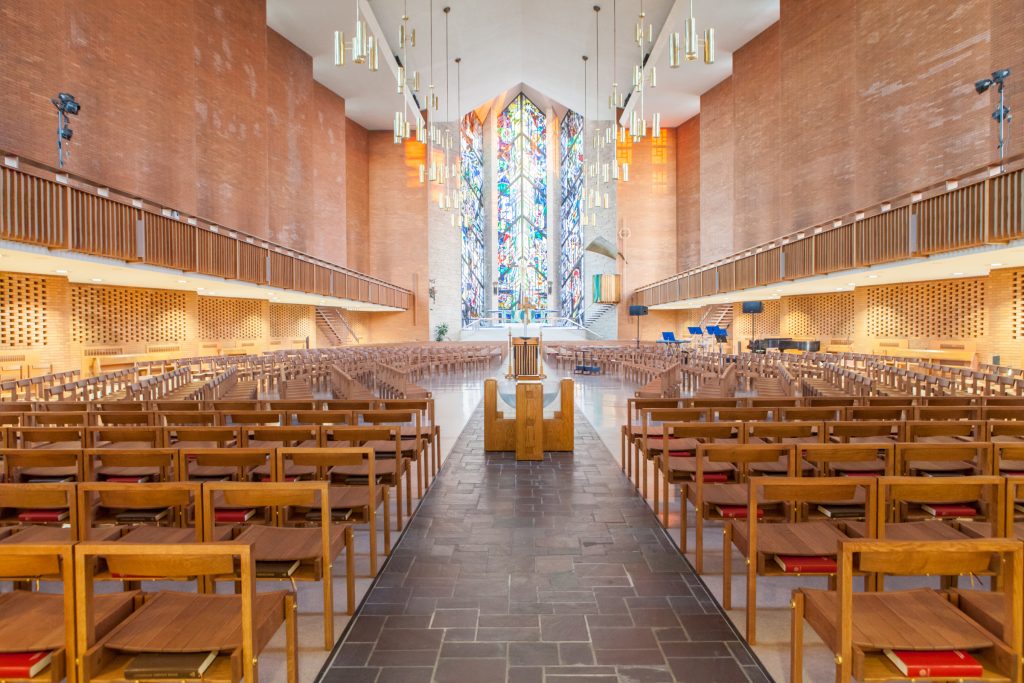
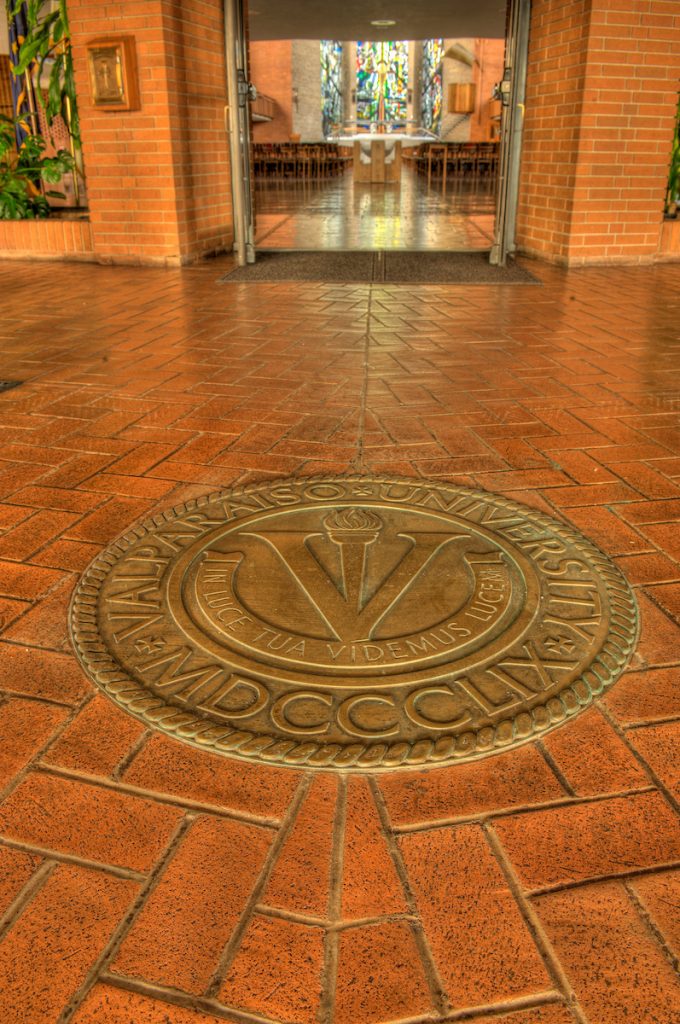
Set into the floor of the narthex is the bronze Great Seal of the University, with its motto, “In Luce Tua Videmus Lucem,” In Thy Light We See Light (Psalm 36:9).
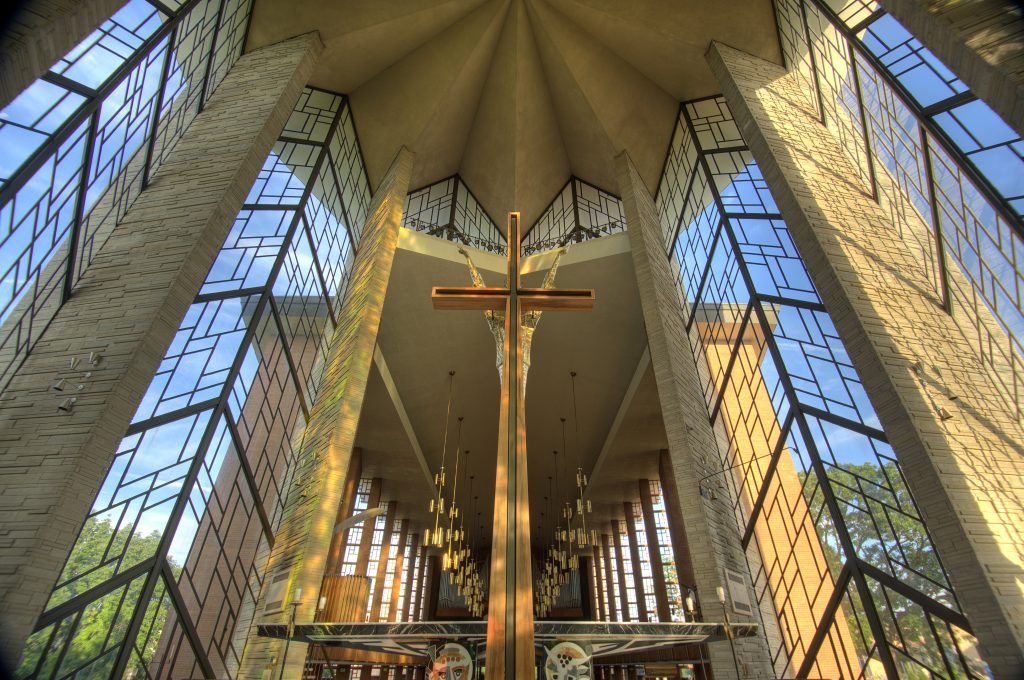
This unique view, taken from behind the altar, shows how the side walls of the nave, or seating area, of the chapel are angled columns of brick that rise 58 feet high. Worshipers returning from communion look out through clear windows into the world in which they are sent.
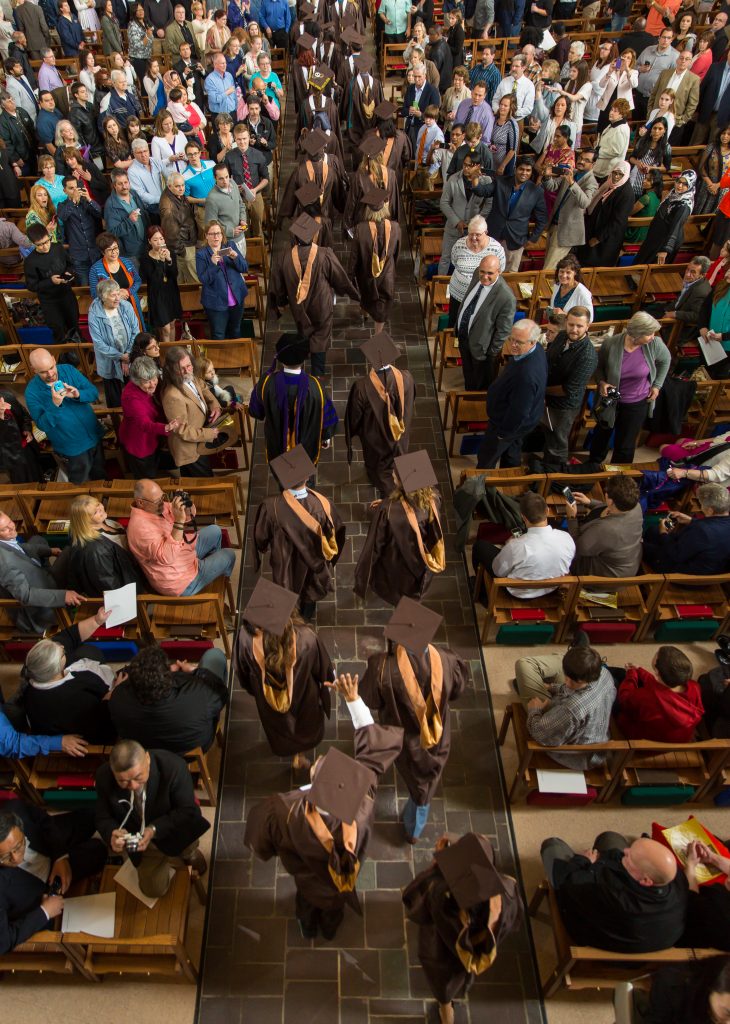
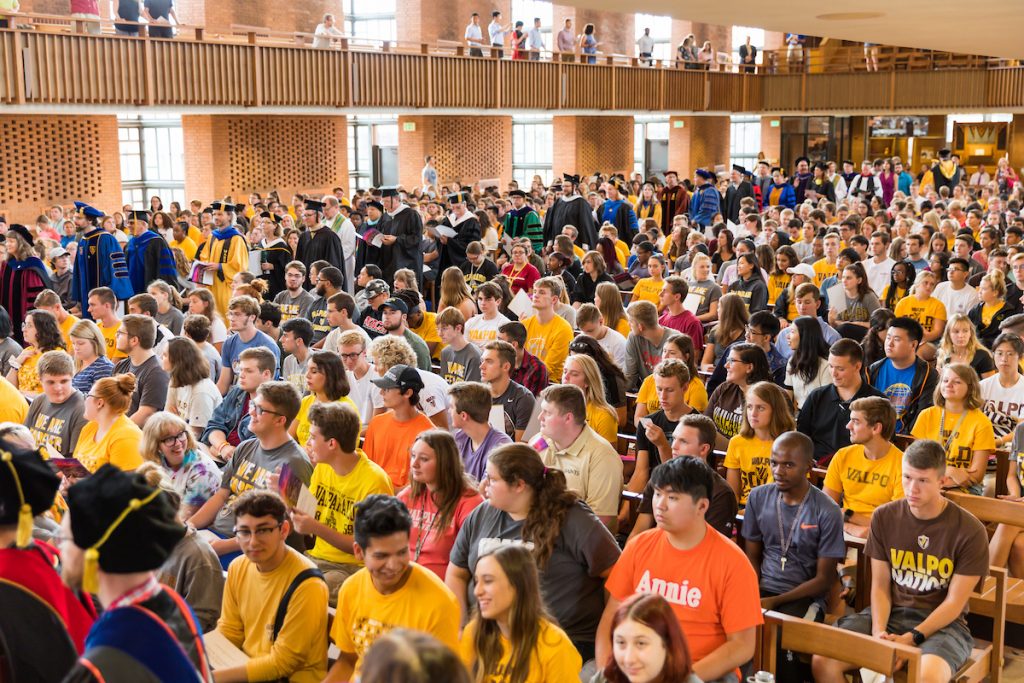
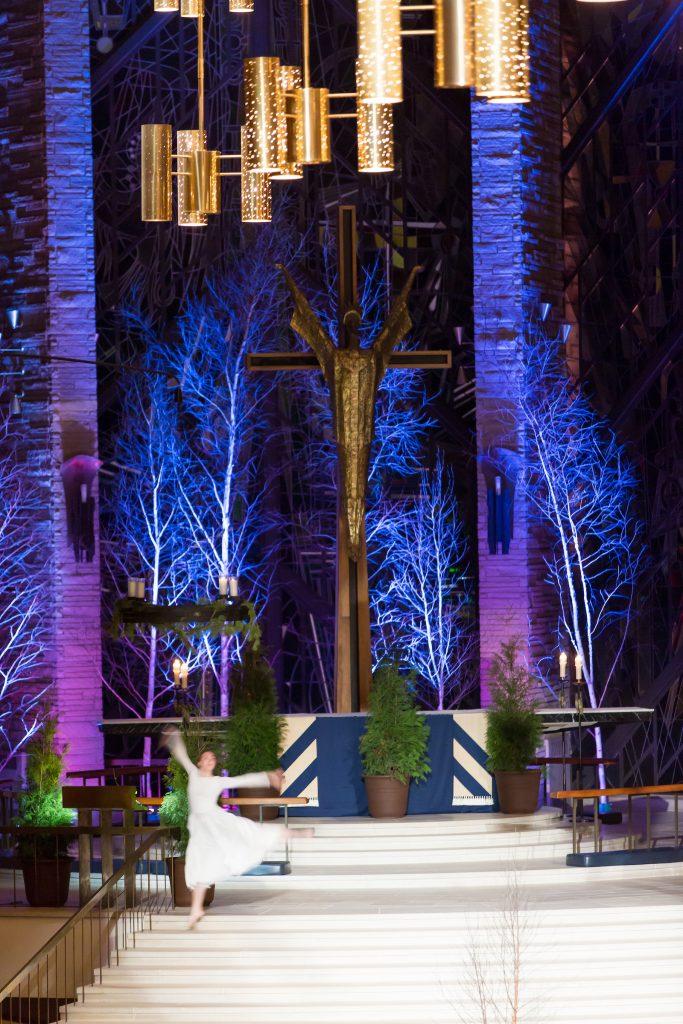
Along with its eight regular worship services each week during the regular academic year, the chapel plays host to a number of events that bring members of the greater Valparaiso community and beyond to our campus.
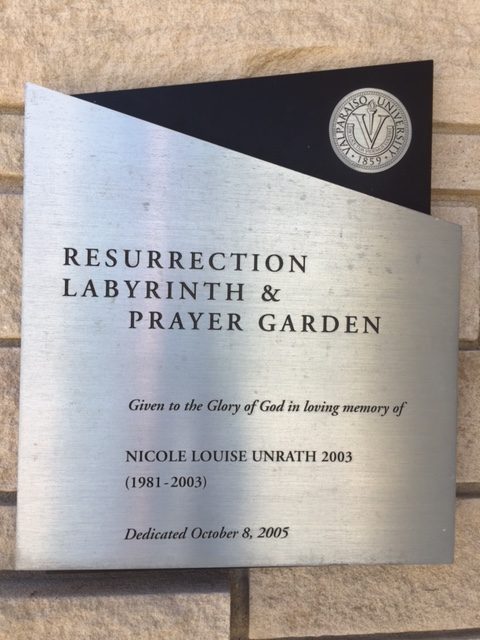
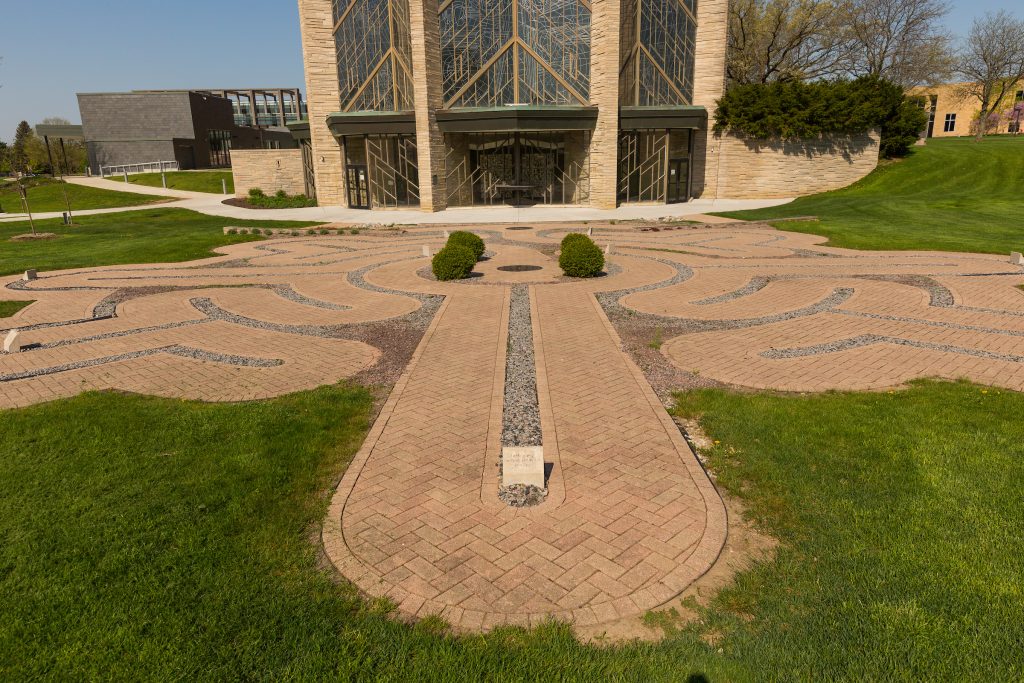
October 8, 2005: Resurrection Labyrinth
Outside the Chapel on the east end of the building is the Resurrection Labyrinth and “I AM” Garden, given in memory of Nicole Unrath, class of 2003, by her family and friends. It was dedicated on Oct. 8, 2005.
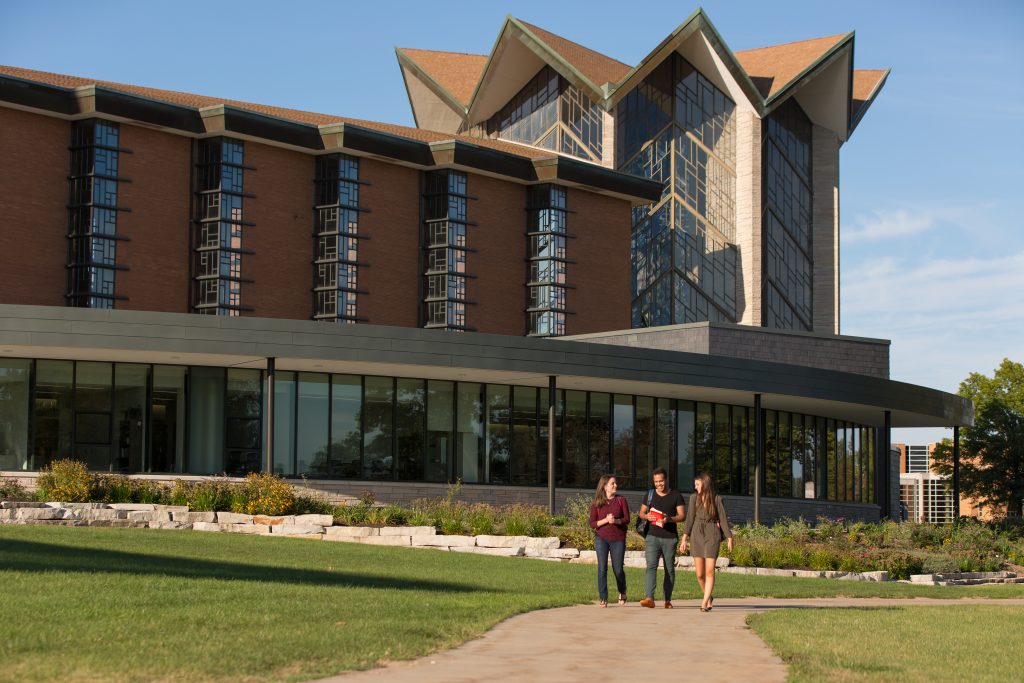
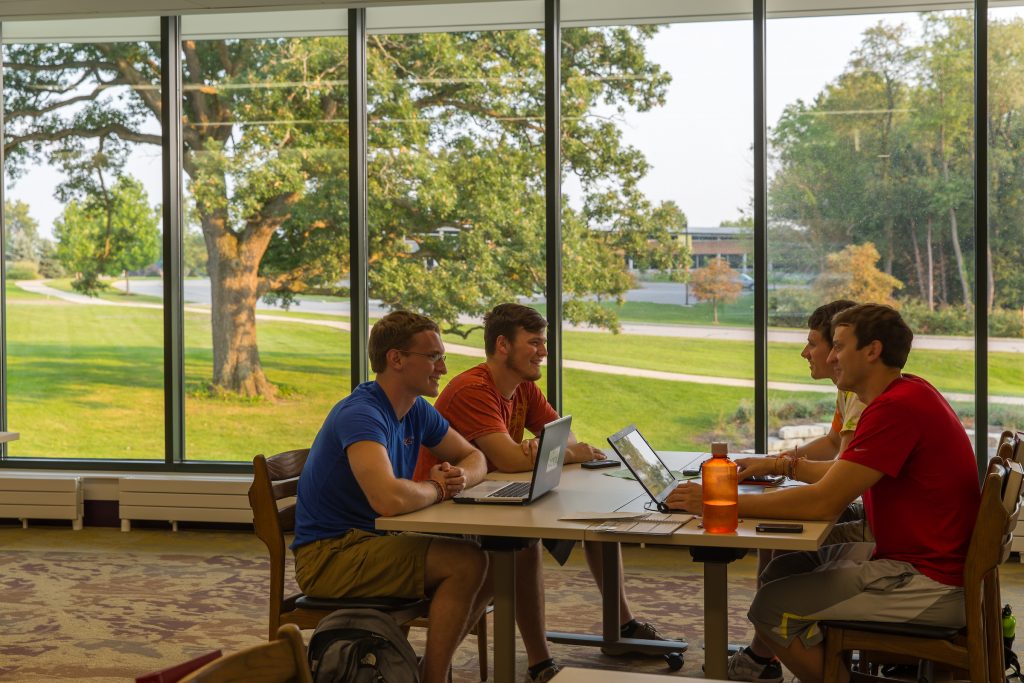
2015: Helge Center
The Kathleen and Mark Helge Center, located adjacent to the Chapel of the Resurrection, was dedicated during Homecoming Weekend of 2015.
Valparaiso University alumni Rev. Mark ’71 and Kathleen Koepp ’71 Helge funded extensive upgrades and renovation of the Chapel of the Resurrection, including the Kathleen and Mark Helge Center, a 9,000-square-foot addition to the Chapel, that brings campus ministries together under one roof. Offices for the Chapel staff, Institute for Leadership and Service, Center for Church Vocations, and Office of Church Relations are found here. The addition also includes rehearsal space for choirs, a commercial kitchen, conference room, multipurpose room, and areas where students gather.
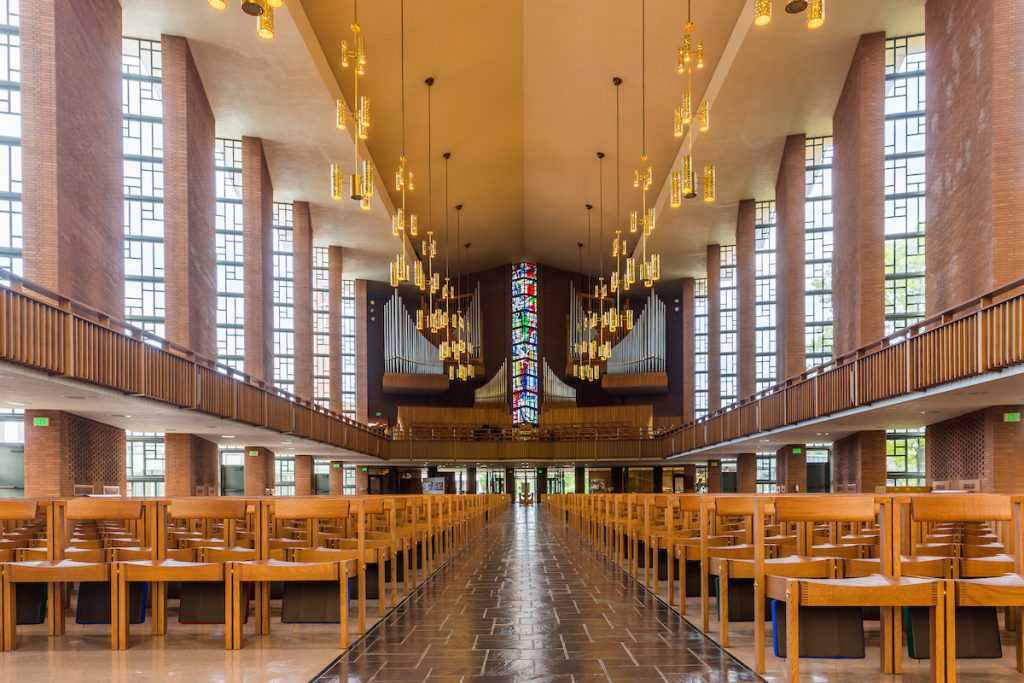
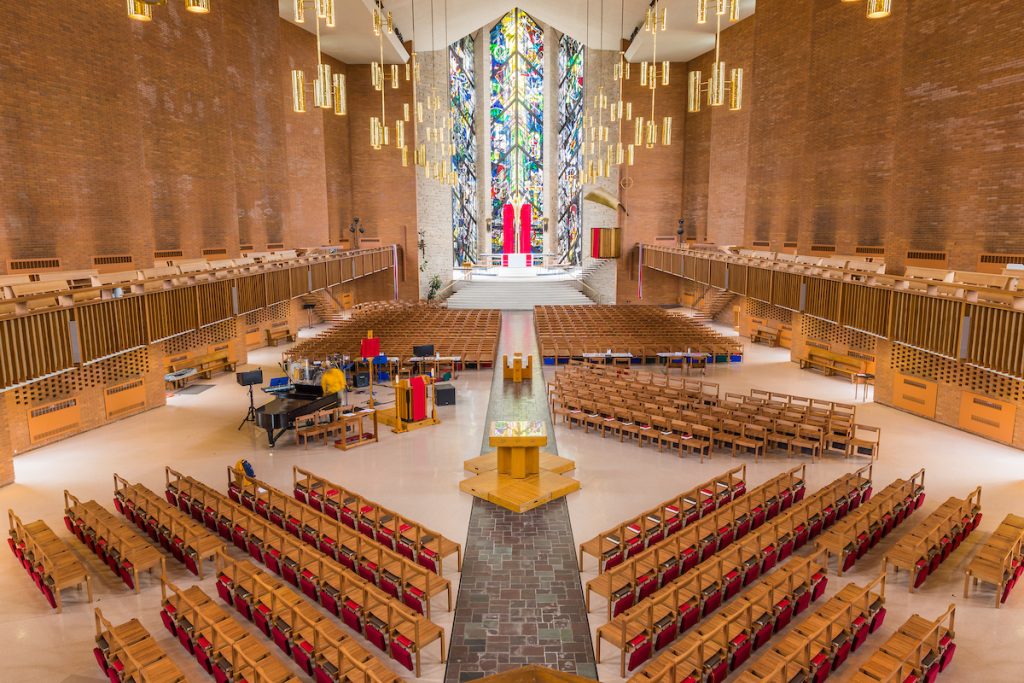
Pews are replaced in the chapel by chairs by Luke Hughes to further enable creative seating in the chapel.
The chair chosen for this space was originally designed by Dick Russell for the new Coventry Cathedral in the 1950s and became an icon of post-war design. The university chapel is one of the largest college chapels in the US and some note its resemblance to Coventry Cathedral. The university and Coventry Cathedral have had a close relationship through the Community of the Cross of Nails for over 50 years, with Valpo receiving a cross of nails in 1965.
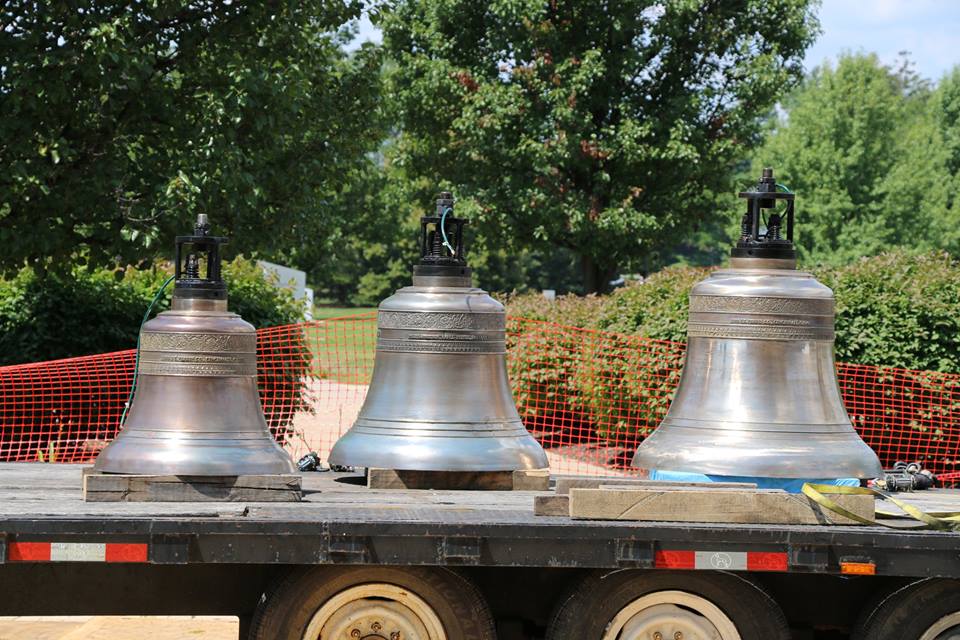
2017: Campanile improvements
Time and weather had taken their toll on the bells of the Brandt Campanile. During the summer of 2017, the 12 bells were removed for polishing and the campanile was rewired. Returned to their place, the restored bells now continue to ring every 15 minutes and also provide a call to worship for the campus.
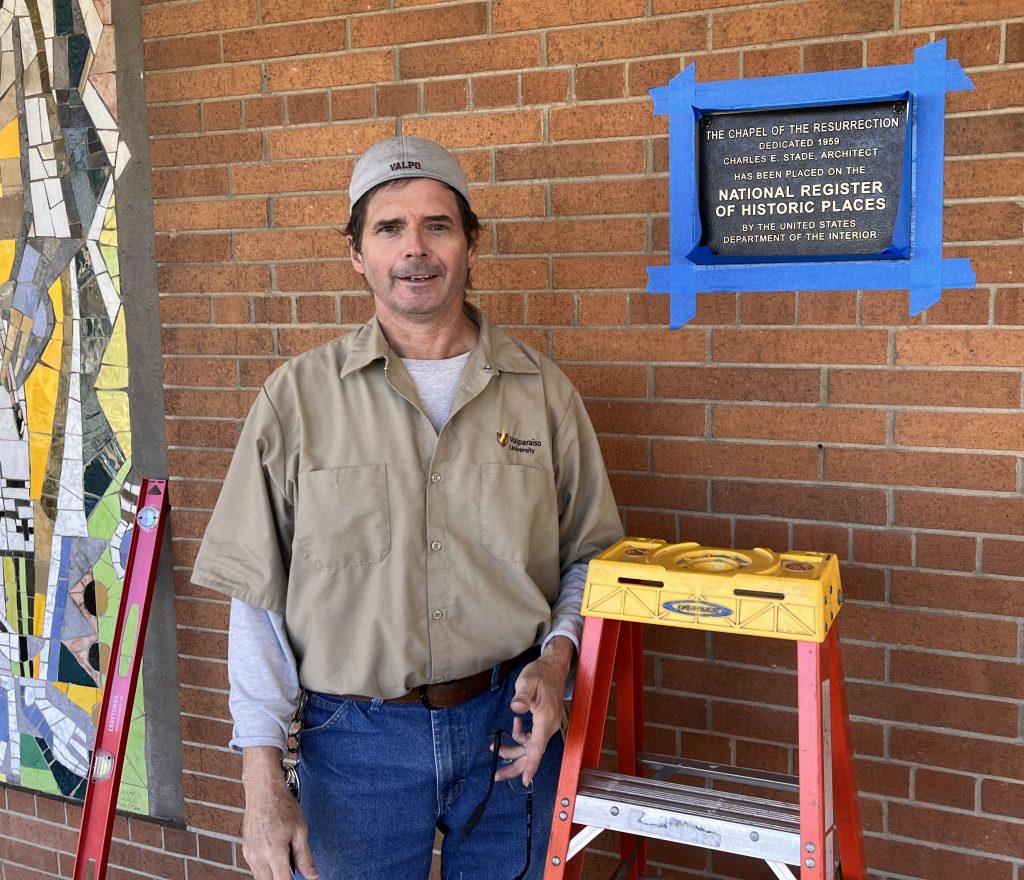
2021: National Register of Historic Places
In November 2021, the Chapel of the Resurrection was added to the National Register of Historic Places, the official list of the Nation’s historic places worthy of preservation.
More about the Chapel
Take a 360-degree look at the building or download our self-guided tour booklet. See the latest virtual campus tour that begins at the Chapel. Watch this Lakeshore PBS “Eye on the Arts” video about the Chapel’s organ.
Indigenous Land Statement
The Chapel of the Resurrection is built on the traditional homelands of several indigenous peoples, most notably the Potawatomi (Bodéwadmik) Nation. The land was ceded by Potawatomi leaders to the U.S. federal authorities on October 26, 1832, as part of the Treaty of Tippecanoe. We meet in this place indebted to this forced generosity.
Some of the indigenous population successfully resisted removal. Members of the Pokagon Band of Potawatomi (Pokégnek Bodéwadmik) established a sovereign government in Dowagiac, Michigan, and continue to live, work, and worship as our neighbors.
